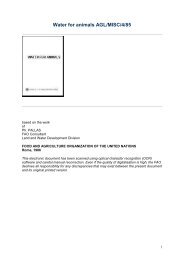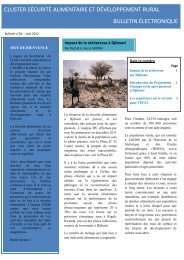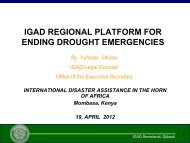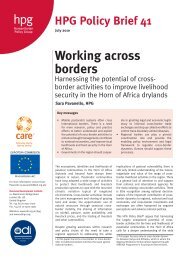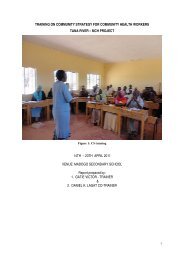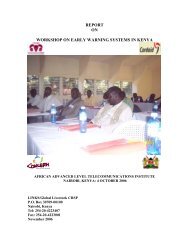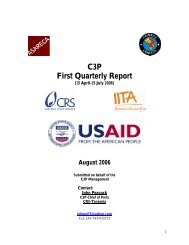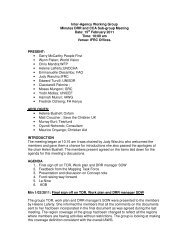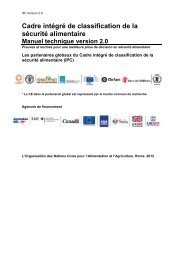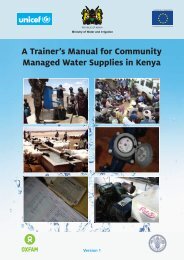Synthesis of Existing Knowledge and Experience on the Provision of ...
Synthesis of Existing Knowledge and Experience on the Provision of ...
Synthesis of Existing Knowledge and Experience on the Provision of ...
Create successful ePaper yourself
Turn your PDF publications into a flip-book with our unique Google optimized e-Paper software.
<str<strong>on</strong>g>of</str<strong>on</strong>g> total regi<strong>on</strong>al investment target 4 regi<strong>on</strong>s. These 4 regi<strong>on</strong>s include SNNPR <str<strong>on</strong>g>and</str<strong>on</strong>g> Oromia, whichhost pastoral populati<strong>on</strong>s (WSDP 2002).The main implementati<strong>on</strong> strategy outlined calls for capitalizing <str<strong>on</strong>g>and</str<strong>on</strong>g> building <strong>on</strong> existing instituti<strong>on</strong>alstructures, promoting decentralized management involving communities in local water governance,bridging technical capacity gaps, <str<strong>on</strong>g>and</str<strong>on</strong>g> promoting partnerships at all levels. However, for both watersupply <str<strong>on</strong>g>and</str<strong>on</strong>g> irrigati<strong>on</strong>, <strong>the</strong> WSDP recognizes that low community participati<strong>on</strong> in projectidentificati<strong>on</strong>, c<strong>on</strong>structi<strong>on</strong>, operati<strong>on</strong> <str<strong>on</strong>g>and</str<strong>on</strong>g> maintenance is an overarching c<strong>on</strong>straint to <strong>the</strong>implementati<strong>on</strong> <str<strong>on</strong>g>of</str<strong>on</strong>g> <strong>the</strong> program, <str<strong>on</strong>g>and</str<strong>on</strong>g> special emphasis is put <strong>on</strong> <strong>the</strong> establishment <str<strong>on</strong>g>and</str<strong>on</strong>g> involvement <str<strong>on</strong>g>of</str<strong>on</strong>g>Water Users’ Associati<strong>on</strong>s (WUAs). It also recognizes o<strong>the</strong>r major c<strong>on</strong>straints, such as <strong>the</strong> shortage<str<strong>on</strong>g>of</str<strong>on</strong>g> skilled manpower at all administrative levels <str<strong>on</strong>g>and</str<strong>on</strong>g> insufficient capacity to implement.The WSDP also notes <strong>the</strong> potential impacts <str<strong>on</strong>g>of</str<strong>on</strong>g> <strong>the</strong> program <strong>on</strong> communities <str<strong>on</strong>g>and</str<strong>on</strong>g> <strong>the</strong>ir instituti<strong>on</strong>s.Special attenti<strong>on</strong> is to be given to how community instituti<strong>on</strong>s <str<strong>on</strong>g>and</str<strong>on</strong>g> local government interact. It alsorecognizes that program activities could affect <strong>the</strong> livelihoods <str<strong>on</strong>g>of</str<strong>on</strong>g> vulnerable <str<strong>on</strong>g>and</str<strong>on</strong>g> marginalized socialgroups, specifically menti<strong>on</strong>ing pastoralists <str<strong>on</strong>g>and</str<strong>on</strong>g> agro-pastoralists in <strong>the</strong> lowl<str<strong>on</strong>g>and</str<strong>on</strong>g>s, <str<strong>on</strong>g>and</str<strong>on</strong>g> that carefulc<strong>on</strong>siderati<strong>on</strong> is required for <strong>the</strong>se issues in program implementati<strong>on</strong>.The Water Supply, Sanitati<strong>on</strong> <str<strong>on</strong>g>and</str<strong>on</strong>g> Hygiene Program (WSSP)In 2004, <strong>the</strong> MoWR launched <strong>the</strong> Water Supply, Sanitati<strong>on</strong> <str<strong>on</strong>g>and</str<strong>on</strong>g> Hygiene Program (WSSP) whichoutlines plans to c<strong>on</strong>struct about 5,500 community-managed rural water supply schemes. Pastoralcommunities in Afar, Somali, Oromia <str<strong>on</strong>g>and</str<strong>on</strong>g> SNNPR Regi<strong>on</strong>s are major beneficiaries (MoWR, 2009). In2006, it was realized that implementati<strong>on</strong> <str<strong>on</strong>g>of</str<strong>on</strong>g> <strong>the</strong> WSSP in pastoral regi<strong>on</strong>s could not be achievedwithout special c<strong>on</strong>siderati<strong>on</strong> for <strong>the</strong> needs <str<strong>on</strong>g>of</str<strong>on</strong>g> lowl<str<strong>on</strong>g>and</str<strong>on</strong>g> areas. This resulted in <strong>the</strong> development <str<strong>on</strong>g>of</str<strong>on</strong>g>Specific Implementati<strong>on</strong> Guidelines for Pastoralist Areas which take into c<strong>on</strong>siderati<strong>on</strong> “<strong>the</strong>envir<strong>on</strong>mental, social, technological, <str<strong>on</strong>g>and</str<strong>on</strong>g> o<strong>the</strong>r peculiarities <str<strong>on</strong>g>of</str<strong>on</strong>g> pastoral communities.” Box 7discusses <str<strong>on</strong>g>and</str<strong>on</strong>g> highlights some <str<strong>on</strong>g>of</str<strong>on</strong>g> <strong>the</strong> central <strong>the</strong>mes menti<strong>on</strong>ed in <strong>the</strong> guidelines.Box 7: Central <strong>the</strong>mes <str<strong>on</strong>g>and</str<strong>on</strong>g> highlights <str<strong>on</strong>g>of</str<strong>on</strong>g> <strong>the</strong> WSSP for Pastoral Areas (based <strong>on</strong> Giovannetti2006)• Water point selecti<strong>on</strong> <str<strong>on</strong>g>and</str<strong>on</strong>g> placement: The way in which <strong>the</strong> guidelines are presented suggests that waterpoint selecti<strong>on</strong> <str<strong>on</strong>g>and</str<strong>on</strong>g> placement is guided more by technical <str<strong>on</strong>g>and</str<strong>on</strong>g> cost c<strong>on</strong>siderati<strong>on</strong>s ra<strong>the</strong>r than how <strong>the</strong>water point will impact <strong>on</strong> local people/livestock/l<str<strong>on</strong>g>and</str<strong>on</strong>g>scape interacti<strong>on</strong>s.• Mobility: Explicitly recognized in <strong>the</strong> document. The guidelines promote c<strong>on</strong>text specific planning, statingthat “a case-by-case basis <str<strong>on</strong>g>of</str<strong>on</strong>g> <strong>the</strong> actual movements <str<strong>on</strong>g>of</str<strong>on</strong>g> a given community is paramount to approachingproperly its water supply issues.” Also recognizes that sedentarizati<strong>on</strong> threatens <strong>the</strong> balance betweenlivestock, pasture <str<strong>on</strong>g>and</str<strong>on</strong>g> water.• Settlement: The guidelines recognize different settlement patterns in pastoral areas. For Afar <str<strong>on</strong>g>and</str<strong>on</strong>g> Somali, 4different settlement patterns are identified: 1) permanent sedentary settlements without pastoralists, 2)permanent sedentary settlements where pastoralists are present for several m<strong>on</strong>ths with <strong>the</strong>ir livestock,3) permanent sedentary settlements where pastoralists spend a few days to a few weeks with <strong>the</strong>irlivestock, 4) n<strong>on</strong> permanent settlements <str<strong>on</strong>g>of</str<strong>on</strong>g> pastoralists with significant but temporary presence <str<strong>on</strong>g>of</str<strong>on</strong>g>livestock.• Participati<strong>on</strong>: The guidelines recommend that defining who <strong>the</strong> ‘community’ is should be d<strong>on</strong>e <strong>on</strong> a case bycase basis. Participati<strong>on</strong> is envisi<strong>on</strong>ed as expressing dem<str<strong>on</strong>g>and</str<strong>on</strong>g> for water supply, participating physically <str<strong>on</strong>g>and</str<strong>on</strong>g>/orfinancially in c<strong>on</strong>structi<strong>on</strong>, <str<strong>on</strong>g>and</str<strong>on</strong>g> taking care <str<strong>on</strong>g>of</str<strong>on</strong>g> operati<strong>on</strong> <str<strong>on</strong>g>and</str<strong>on</strong>g> maintenance. A user elected CommunityWater, Sanitati<strong>on</strong> <str<strong>on</strong>g>and</str<strong>on</strong>g> Hygiene Committees should represent <strong>the</strong> community in planning <str<strong>on</strong>g>and</str<strong>on</strong>g> management<str<strong>on</strong>g>of</str<strong>on</strong>g> water facilities.• Highl<str<strong>on</strong>g>and</str<strong>on</strong>g> influence: The guidelines recognize that due to low technical capacity in pastoral regi<strong>on</strong>s,pr<str<strong>on</strong>g>of</str<strong>on</strong>g>essi<strong>on</strong>als from highl<str<strong>on</strong>g>and</str<strong>on</strong>g> regi<strong>on</strong>s are usually brought in to fill gaps bringing with <strong>the</strong>m highl<str<strong>on</strong>g>and</str<strong>on</strong>g>approaches which are different to those appropriate in <strong>the</strong> lowl<str<strong>on</strong>g>and</str<strong>on</strong>g>s.• Impact: The document acknowledges that large capacity water points could attract too many livestock fora given area. It recommends that water points not exceed a size that waters a maximum <str<strong>on</strong>g>of</str<strong>on</strong>g> 4,500 head <str<strong>on</strong>g>of</str<strong>on</strong>g>cattle a day <str<strong>on</strong>g>and</str<strong>on</strong>g> that <strong>the</strong>y are spaced about 20km apart to avoid overgrazing.• Community C<strong>on</strong>tributi<strong>on</strong>: The guidelines recommend that <strong>the</strong> community should c<strong>on</strong>tribute 5% in cash <str<strong>on</strong>g>and</str<strong>on</strong>g>5% in kind to c<strong>on</strong>structi<strong>on</strong>. However, it also menti<strong>on</strong>s that requiring a cash c<strong>on</strong>tributi<strong>on</strong> could excludemost communities from <strong>the</strong> benefit <str<strong>on</strong>g>of</str<strong>on</strong>g> <strong>the</strong> WSSP.52



